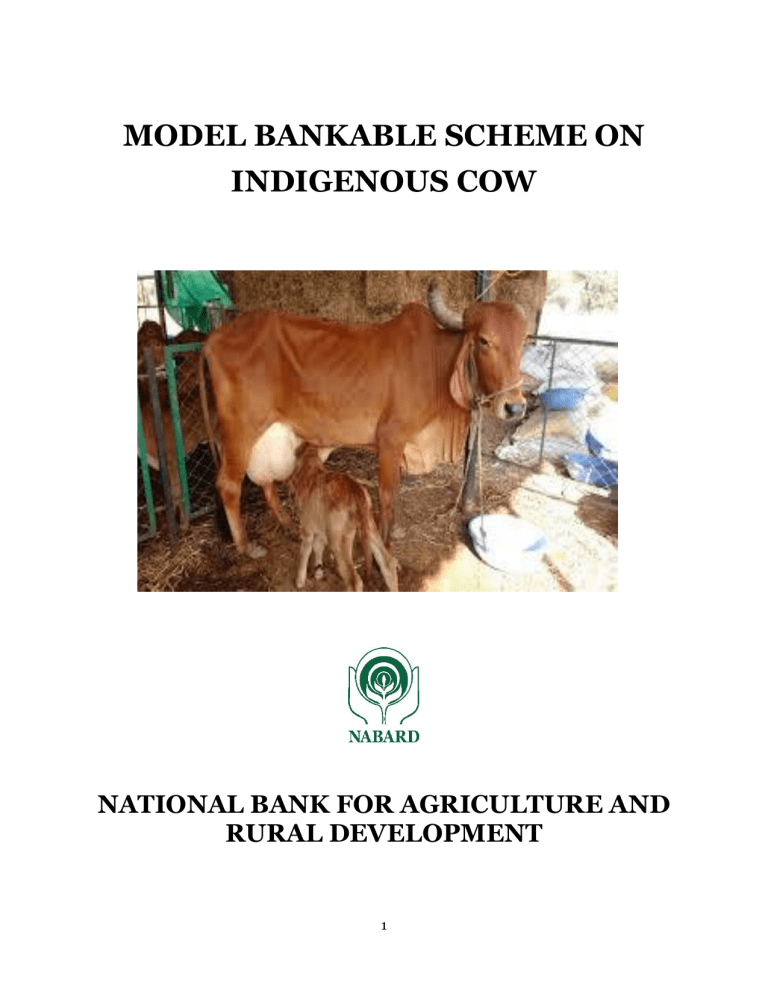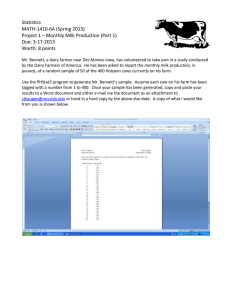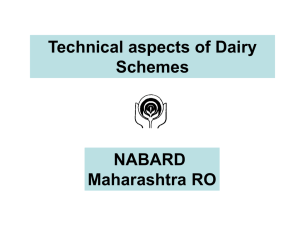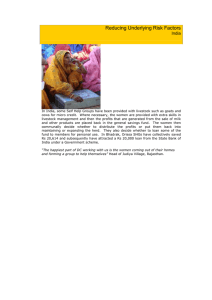
MODEL BANKABLE SCHEME ON INDIGENOUS COW NATIONAL BANK FOR AGRICULTURE AND RURAL DEVELOPMENT 1 Project on Indigenous Cow Rearing Dairying is an important source of subsidiary income to small/marginal farmers and agricultural labourers. Dairying has become an important secondary source of income for millions of rural families and has assumed the most important role in providing employment and income generating opportunities particularly for marginal and women farmers. It is estimated that about 70 million rural households in India own livestock of one species or the other. Women constitute about 69% of workforce engaged in livestock sector. The resource-poor small and marginal farmers and landless labourers own majority of the livestock resources. Hence sustainable development of the livestock sector would lead to more inclusive development and empowerment of women. The manure from animals provides a good source of organic matter for improving soil fertility and crop yields. The gobar gas from the dung is used as fuel for domestic purposes as also for running engines for drawing water from well. As per the National Livestock Policy, 2013, is aimed at increasing livestock productivity and production in a sustainable manner, while protecting the environment, preserving animal biodiversity, ensuring bio-security and farmers’ livelihood. This objective would be achieved by promotion conservation of animal bio-diversity; conservation and genetic improvement of important indigenous breeds of livestock. 2. Scope for Indigenous dairy farming and its Importance. The total milk production in the country for the year 2015-16 was at 155.50 million metric tones. Per capita daily milk availability in India is 337 gm as against recommended allowance of 250 gm. The average productivity (per day milk yield) of cross bred, indigenous cows and buffaloes in India was 7.02 Kg, 2.36 Kg and 4.89 Kg (Basic Animal Husbandry Statistics, Ministry of Agriculture, GoI). Although the productivity of indigenous cattle is less as compared to cross bred animals, rearing of indigenous breeds is observed to be more profitable due to their merits viz better disease resistance, more suitability for low input management system, better survival in local environment, suitable for draught work, etc. Moreover, resource poor small and marginal farmers in India are rearing indigenous animals traditionally without much difficulty. 2 3. Financial Assistance Available from Banks/NABARD for Indigenous Cow Farming. 3.1. Loan from banks with refinance facility from NABARD is available for starting dairy farming. For obtaining bank loan, the beneficiaries should apply to the nearest branch of a commercial, co-operative or Regional Rural Bank in their area in the prescribed application form which is available in the branches of financing banks. 3.2. For any dairy scheme with very large outlays, detailed reports will have to be prepared. The items of finance would include capital asset items such as purchase of milch animals, construction of sheds, purchase of equipments etc. The feeding cost during the initial period of one/two months is capitalised and given as Term Loan. Facilities such as cost of land development, fencing, digging of well, commissioning of diesel engine/pumpset, electricity connections, essential servants' quarters, godown, transport vehicle, milk processing facilities etc. can be considered for loan. Cost of land is not considered for loan. 4. Scheme Formulation for bank loan. 4.1 A Scheme can be prepared by a beneficiary after consulting local technical persons of State Animal Husbandry Department, DRDA, Dairy Co-operative Society / Union / Federation / 3 commercial dairy farmers. If possible, the beneficiaries should also visit progressive dairy farms and government / military / agricultural university dairy farms in the vicinity and discuss the profitability of dairy farming. A good practical training and experience in dairy farming will be highly desirable. The dairy co-operative societies if existing in the villages would provide all supporting facilities particularly marketing of fluid milk. Nearness of dairy farm to such a society, veterinary aid centre, artificial insemination centre should be ensured. There is a good demand for milk, if the dairy farm is located near urban centre. 4.2 The scheme should include information on land, livestock markets, availability of water, feeds, fodders, veterinary aid, breeding facilities, marketing aspects, training facilities, experience of the farmer and the type of assistance available from State Government, dairy society/union/federation. 4.3 The scheme should also include information on the number and types of animals to be purchased, their breed, production performance, cost and other relevant input and output costs with their description. Based on this, the total cost of the project, margin money to be provided by the beneficiary, requirement of bank loan, estimated annual expenditure, income, profit and loss statement, repayment period, etc. can be worked out and shown in the Project report. A format developed for formulation of project report for Cattle farming is given in Annexure I. 5. Scrutiny of Schemes by banks. The scheme so formulated should be submitted to the nearest branch of bank. The bank's officers can assist in preparation of the scheme for filling in the prescribed application form. The bank will then examine the scheme for its technical feasibility and economic viability. (A) Technical Feasibility - this would briefly include 1. Nearness of the selected area to veterinary, breeding and milk collection centre and the financing bank's branch. 2. Availability of good quality animals in nearby livestock market 3. Availability of training facilities. 4. Availability of good grazing ground/lands. 5. Availability of Green/dry fodder, concentrate feed, medicines etc. 6. Availability of veterinary aid / breeding centres and milk marketing facilities near the scheme area. (B) Economic Viability - this would briefly include 4 1. Unit Cost 2. Input cost for feeds and fodders, veterinary aid, breeding of animals, insurance, labour and other overheads. 3. Output costs i.e. sale price of milk, manure, gunny bags, male/female calves, other miscellaneous items etc. 4. Income-expenditure statement and annual gross surplus. 5. Cash flow analysis. 6. Repayment schedule (i.e. repayment of principal loan amount and interest). Other documents such as loan application forms, security aspects, margin money requirements etc. are also examined. A field visit to the scheme area is undertaken for conducting a technoeconomic feasibility study for appraisal of the scheme. 6. Sanction of Bank Loan and its Disbursement. After ensuring technical feasibility and economic viability, the scheme is sanctioned by the bank. The loan is disbursed in kind in 2 to 3 stages against creation of specific assets such as construction of sheds, purchase of equipments and machinery, purchase of animals and recurring cost on purchase of feeds/fodders for the initial period of one/two months. The end use of the funds is verified and constant follow-up is done by the bank. 7. Lending terms - General 7.1 Outlay Outlay of the project depends on the local conditions, unit size and the components included in the project. Prevailing market prices may be considered to arrive at the outlay. 7.2 Margin Money: Margin depends on the category of the borrowers and range from 5 to 25%. 7.3 Interest Rate for ultimate borrower: Banks are free to decide the rates of interest within the overall guidelines. However, for working out the financial viability and bankability of the model projects we have assumed the rate of interest as 12 % p.a. 7.4 Security Security will be as per NABARD/RBI guidelines issued from time to time. 7.5 Repayment period of loan 5 Repayment period depends upon the gross surplus in the scheme. The loan will be repaid in suitable monthly/quarterly instalments usually within a period of five to seven years. 7.6 Insurance The animals and capital assets may be insured annually or on long term master policy, where ever it is applicable. 7.7 Training For training entrepreneur may contact NDRI, Karnal , Email id – ndribnq@kar.nic.in Phone No. +91-80-225715399, 25711119 7.8 Project Preparation Preparation of Project entrepreneur may contact CEO, Nabcons, Rajendra Place, New Delhi. Contact No. 011-41539355 A model project with 2 Indigenous cow unit is given as Annexure II. This is indicative and the applicable input and output costs as also the parameters observed at the field level may be incorporated Annexure I FORMAT FOR PROJECT REPORT PREPARATION - DAIRY FARM 1. GENERAL i) Nature and objectives of the proposed scheme ii) Details of proposed investments iii) Specification of the project area iv) Name of the financing bank branch 6 v) Status of beneficiary: (individual/Partnership/Company/Corporation/Co-operative Society / Others) vi) Details of borrowers profile (a) Capability (b) Experience (c) Financial Soundness (d) Technical/Other special Qualifications (e) Technical/Managerial Staff and adequacy thereof 2. TECHNICAL ASPECTS : a) Location, Land and Land Development : i) Location details of the project ii) Total Area of land and its cost iii) Site map iv) Particulars of land development, fencing, gates, etc. b) Civil Structures : Detailed cost estimates along with measurements of various civil structure - Sheds - Store room - Milk room - Quarters, etc. c) Equipment/Plant and Machinery : i) Chaff cutter ii) Silo pit iii) Milking machine iv) Feed grinder and mixer v) Milking pails/milk cans vi) Biogas plant vii) Bulk coolers viii)Equipment for manufacture of products ix) Truck/van (price quotations for the above equipments) 7 d) Housing : i) Type of housing ii) Area requirement - Adults - Heifers (1-3 years) - Calves (less than 1 year) e) Animals : i) Proposed species ii) Proposed breed iii) Source of purchase iv) Place of purchase v) Distance (km.) vi) Cost of animal (Rs.) f) Production parameters : i) Order of lactation ii) Milk yield (ltrs. per day) iii) Lactation days iv) Dry days v) Conception rate vi) Mortality(%) - Adults - Young stock g) Herd projection (with all assumptions) : h) Feeding : i) Source of fodder and feed - Green fodder - Dry fodder - Concentrates ii) Fodder crop rotations - Kharif - Rabi 8 - Summer iii) Fodder cultivation expenses iv) Requirement and costs : Quantity required (kg./day) Cost(Rs. / Kg) Lactation Green Fodder Dry Fodder Concentrates i) Breeding Facilities : i) Source : ii) Location : iii) Distance (km.) : iv) Availability of semen : v) Availability of staff : vi) Expenditure per animal/year j) Veterinary Aid : i) Source ii) Location iii) Distance (km.) iv) Availability of labour and other staff v) Types of facilities available vi) If own arrangements are made a) Employed a veterinary doctor/stockman/consultant b) Periodicity of visit c) Amount paid/visit (Rs.) vii)Expenditure per animal per year (Rs.) k) Electricity : i) Source ii) Approval from SEB iii) Connected load 9 Dry Period Young Stock iv) Problems of power failure v) Arrangements for generator l) Water : i) Source ii) Quality of water iii) Availability of sufficient quantity for drinking, cleaning and fodder production iv) If investment has to be made, type of structure, design and cost m) Marketing of milk : i) Source of sales ii) Place of disposal iii) Distance (km.) iv) Price realised - (Rs. per liter of milk) v) Basis of payment vi) Periodicity of payment n) Marketing of other products : i) Animal - age - place of sale - price expected ii) Manure - Qty./animal Price/unit (Rs.) iii) Empty gunny bags - Number - Cost/bag (Rs.) o) Beneficiary's experience : p) Comments on technical feasibility : q) Government restrictions, if any : 3. FINANCIAL ASPECTS : i) Project Cost 10 Sr. No. Item Physical Unit and Cost (Rs.) Specification Capital Costs Total Capital Costs(A) Recurring Costs Total Recurring Costs (B) Total Project Cost (A+B) ii) Down payment/margin/subsidy (Indicate source & extent of subsidy): iii) Financial viability (comment on the cash flow projection on a farm model/unit and enclose the same.) Particulars : a) Internal Rate of Return (IRR) : b) Benefit Cost Ratio (BCR) : c) Net Present Worth (NPW) : iv) Financial position of the borrowers (to be furnished in case of corporate bodies/partnership firms) a) Profitability Ratio : i) GP Ratio ii) NP Ratio b) Debt Equity Ratio : c) Whether Income Tax & other tax obligations are paid upto date : d) Whether audit is upto date (enclose copies of audited financial statements for the last three years) vi) Lending Terms : i) Rate of Interest : ii) Grace Period : iii) Repayment Period : iv) Nature of Security : v) Availability of Government guarantee wherever necessary : 11 4. INFRASTRUCTURAL FACILITIES : a) Availability of technical staff with bank/implementing authority for monitoring b) Details of i) technical guidance ii) training facilities iii) Govt. support /extension support c) Tie-up arrangements with marketing agencies for loan recovery d) Insurance - Type of policy - Periodicity - Rate of premium e) Whether any subsidy is available, if so amount per unit f) Arrangements for supply of green fodder and cattle feed 12 Annexure II . Model Unit Cost and Economics of a 2 Indigenous cow unit A. Project Cost Amt Rs Cost of milch animals including transportation cost Cost of equipment 62000 2000 Capital cost 64000 Cost of concentrate feed for first batch for first month Insurance of milch animals 1080 3000 Recurring cost 4080 Total cost or Say 68040 68100 Margin (10%) Bank Loan 6800 61300 B. Techno economic parameters Breed of Animal Indigenous (Gir, Sahiwal, Graded) No. of Animals 2 Cost of Animals (Rs.) 31000 Transportation Cost/Animal (Rs.) 1000 Average Milk Yield (litres) 4 Cost of equipment per animal (Rs.) 1000 Insurance premium (% per annum) 5 Veterinary aid/animal/ year (Rs.) 300 Cost of concentrate feed (`Rs./kg) 18 Cost of dry fodder (`Rs./kg) 2 Misc expenses/animal/year (Rs.) 200 Margin (%) 10 Rate of interest (%) 12 Repayment period 6 Selling price of milk/litre (Rs./ litre) 27 Lactation days 270 Dry days 120 Freshly calved animals in 2nd or 3rd lactation are purchased in two batches at an interval of 4 to 6 months. Cost of rearing calves not considered as it will be nullified by their sale value or retention value. Green fodder grown on field bunds is considered for feeding of animals. Value of manure not taken into account 13 Feeding Schedule Per Day Conc. Feed Green Fodder Dry Fodder Total Lactation Days Dry Days Price (Rs) Qty. (kg) Cost Per Day (Rs) Qty. (kg) Cost Per Day (Rs) 18 2 36 1 18 0 20 0 15 0 2 3 6 4 8 42 26 Lactation Chart Years Lactation Days Dry Days 1 2 425 120 3 4 510 220 515 215 5 515 215 530 200 C. Economics Particulars Sale of Milk Total Cost of feeding during lactation Cost of feeding during dry period Veterinary aid and breeding charges Insurance charges Total Surplus 1 45900 45900 2 55080 55080 3 55620 55620 4 55620 55620 Amt Rs 5 57240 57240 17850 21420 21630 21630 22260 5040 9240 9030 9030 8400 450 3100 26440 19460 600 3100 34360 20720 600 3100 34360 21260 600 3100 34360 21260 600 3100 34360 22880 1 64000 2 3 26340 90340 45900 -44440 163610 178392 14782 1.09:1 >33% 34260 34260 55080 20820 34260 34260 55620 21360 D. Calculation of BCR and IRR Capital Costs Recurring Cost Total Costs Benefit Net Benefit PW Costs @ 15% PW Benefits @ 15% NPW B.C. Ratio I.R.R. (%) $ Salvage value of animals and residual value of other capital assets not taken into account 14 4 34260 34260 55620 21360 5$ 34260 34260 57240 22980 E. Repayment schedule Year 1 2 3 4 5 Loan Outstanding 61300 51300 40300 27800 14300 Gross Surplus Interest Principal 19560 20820 21360 21360 22980 7356 6156 4836 3336 1716 10000 11000 12500 13500 14300 Total Repayment 17356 17156 17336 16836 16016 Surplus 2204 3664 4024 4524 6964 DISCLAIMER The views expressed in this model project are advisory in nature. NABARD assume no financial liability for anyone using this project report for any purpose. The actual costs and returns will have to be taken on a case by case basis considering the specific requirements of projects. ******************** 15 16 17



